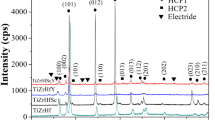The paper examines the microstructure, phase composition, and resistivity of Si3N4-based composites depending on ZrC concentration and isothermal holding temperature. It is established that ZrCxNy forms in the composites during hot pressing. Its amount is determined only by isothermal holding temperature. It is shown that the resistivity and porosity of the composites depend not so much on the rate of chemical reactions as on the agglomeration of the starting powders when mixed. Addition of 10 to 20 vol.% zirconium carbide substantially changes the aggregation–disaggregation ratio. The reproducible resistivity of 0.5–10 Ω ∙ cm is reached. Thus these materials can be used as a resistive layer of small-size converters to perform under intensive heat exchange.
Similar content being viewed by others
References
V. Ya. Petrovsky and S. R. Zbigniew, “Densification, microstructure and properties of electroconductive Si3N4–TaN composites. I. Densification and microstructure,” J. Europ. Ceram. Soc., 21, 219–235 (2001).
V. Ya. Petrovsky and S. R. Zbigniew, “Densification, microstructure and properties of electroconductive Si3N4–TaN composites. II. Electrical and mechanical properties,” J. Europ. Ceram. Soc., 21, 237–244 (2001).
G. G. Gnesin, E. I. Gervits, L. A. Shipilova, et al., “A Si3N4–ZrC resistive composite I. Conductivity concentration dependence,” Powder Metall. Met. Ceram., 29, No. 4, 325–328 (1990).
G. G. Gnesin, E. I. Gervits, L. A. Shipilova, et al., “Si3N4–ZrC resistive composition. II. Temperature dependence of electrical conductivity,” Powder Metall. Met. Ceram., 29, No. 6, 483–486 (1990).
V. Petrovskij, Silicon Nitride Ceramics [in Polish], ITME, Warsaw (1993), p. 53.
T. Ya. Kosolapova, Carbides [in Russian], Metallurgiya, Moscow (1968), p. 299.
G. P. Shveikin, Yu. G. Alyamovskii, Yu. G. Zainulin, et al., Variable-Composition Compounds [in Russian], Sverdlovsk (1984), p. 300.
A. I. Gusev and A. A. Rempel’, Structural and Phase Transitions in Nonstoichiometric Compounds [in Russian], Nauka, Moscow (1988), p. 308.
G. V. Samsonov, Nitrides [in Russian], Naukova Dumka, Kiev (1969), p. 380.
G. N. Dul’nev, V. I. Malarev, and V. V. Novikov, “Effect of particle size on the critical concentration of the conducting phase in P/M materials,” Powder Metall. Met. Ceram., 31, No. 1, 59–63 (1992).
Author information
Authors and Affiliations
Corresponding author
Additional information
Translated from Poroshkovaya Metallurgiya, Vol. 48, No. 9–10 (469), pp. 88–99, 2009.
Rights and permissions
About this article
Cite this article
Kirilenko, E.V., Derii, A.I. & Petrovskii, V.Y. Dependence of the resistivity of hot-pressed Si3N4–ZrC composites on their composition. Powder Metall Met Ceram 48, 560–568 (2009). https://doi.org/10.1007/s11106-010-9168-x
Received:
Published:
Issue Date:
DOI: https://doi.org/10.1007/s11106-010-9168-x




